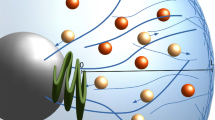Abstract.
Using the Monte Carlo technique, Ca2+ dynamics were simulated in the absence and presence of vesicles to gain better insight into what governs quantal release. A vesicle, represented as a flat, infinitely thin surface, was positioned parallel to the plasma membrane at a chosen distance from the locus of Ca2+ entry. Because vesicles act as important diffusion barriers after the synchronous opening of Ca2+ channels (as occurs during evoked release), [Ca2+] close to the plasma membrane reaches higher levels than it would in the absence of vesicles. The rise in [Ca2+] is greater under larger vesicles close to the plasma membrane, which thus have a higher probability of release. The power–law relationship between the [Ca2+] and the probability of release, and the cubic relationship between the vesicular diameter and its volume can make this relationship very steep. In contrast, when release occurs owing to fluctuations of [Ca2+] – as a result of Ca2+ release from an internal store or asynchronous opening of Ca2+ channels (during spontaneous release) – the effect of vesicles as diffusion barriers is less pronounced and vesicles of different sizes should have a similar probability of release. Since the preferential release of large vesicles depends on how the Ca2+ needed for secretion is raised (synchronously versus asynchronously), the quantal size of evoked and spontaneous release should differ. The main factors influencing the preferential release of large vesicles are the distance between vesicles and the plasma membrane, the concentration of Ca2+ buffers, and single-channel Ca2+ flux. Vesicles also have a pronounced effect on Ca2+ binding to buffers and on the spatio-temporal distribution of bound buffers. The greater the vesicular size and the closer their position to the plasma membrane, the more fixed buffers will be bound near the plasma membrane because of limited diffusion of Ca2+. Since bound fixed buffers act as "memory elements", such a change in their spatial distribution will further enhance the probability of release of large vesicles during stimulation.
Similar content being viewed by others
Author information
Authors and Affiliations
Corresponding author
Additional information
Electronic Publication
Rights and permissions
About this article
Cite this article
Glavinović, M., Rabie, H. Monte Carlo evaluation of quantal analysis in the light of Ca2+ dynamics and the geometry of secretion. Pflügers Arch - Eur J Physiol 443, 132–145 (2001). https://doi.org/10.1007/s004240100631
Received:
Revised:
Accepted:
Published:
Issue Date:
DOI: https://doi.org/10.1007/s004240100631




